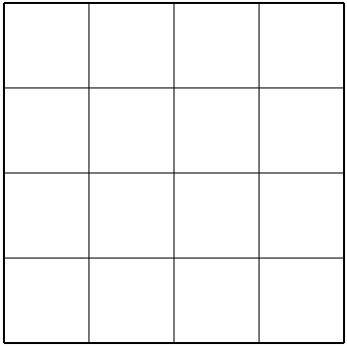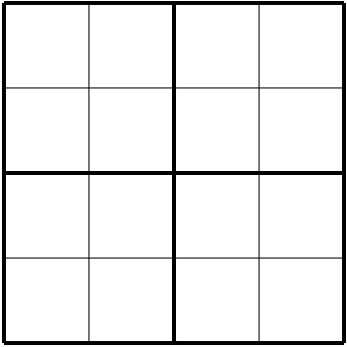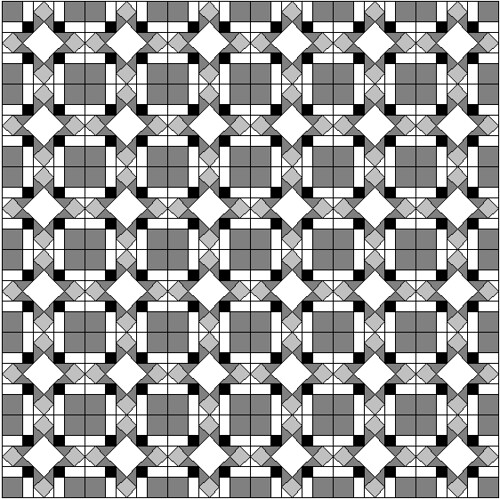As with 4 patch and 9 patch blocks, 16 patch blocks are identified by the grid you can superimpose on top of them. For 16 patch blocks, the grid type is a 4 x 4 layout.
The simplest example of a 16 patch is (strangely enough) the 16 patch block.
When placed in a quilt, the 16 patch is indistinguishable from a 4 patch - the only difference would be the method in which the block was made. Even then, you could simply join four 4 patch blocks together to make a 16 patch, although AmandaJean has written a great tutorial for making 36 patch block from strips of fabric, that could easily be adapted to make a 16 patch.
There are an enormous number of 16 patch blocks out there, so I'll just show you a few examples. Some are easy to identify as a 16 patch, such as Clay's Choice which is simply made using squares and half square triangles (tutorial here).
Even placed within a quilt, it is quite easy to see the blocks.
And the Hour glass block, again made using squares and large half square triangles.
It is a little trickier to see the blocks when Hour glass is used in a quilt (it appears to be made of alternating 4 patches and half square triangles), although the secondary pattern of hidden stars is pretty cool.
Many of the 16 patch blocks I've found are simply made using half square triangles and squares in various arrangements (each of the titles for these blocks links to its tutorial).
Pieced Star
Susannah
and Windblown Square
There are also examples of 16 patch blocks that aren't quite so obvious - some of the component that make up the blocks are more complex, and the centre can be set on point which makes the grid type a bit harder to see.
Crown of Thorns is one such example. At first glance it looks like a fairly complex block (and at second glance if I'm honest!) The way to identify it is a 16 patch is by looking at one of the sides of the block - if you look closely you can see each side can be divided into 4 equal parts, so the block can have a 4x4 grid superimposed on it (and hence it is a 16 patch block).
UPDATE: In response to a couple of comments left on this post, I just wanted to clarify that the type of block does not necessarily relate to how it will be constructed. The three examples below (Crown of Thorns, Temple Court and Another Star) are all 16 patch blocks, due to the fact that they can all be divided into 16 equal sized squares in order to calculate the size of each of the patches. As it has been pointed out in these comments, they would indeed by constructed like a 9-patch (three units by three units) but for the purposes of the maths involved in these blocks it is critical to be able to see that they are made up of 16 equal sized squares in a 4x4 layout. If anyone would like me to clarify this further, please don't hesitate to leave a comment or send me an email :o)
It is reasonably easy to see Crown of Thorns set out in a quilt (again it creates a really cool secondary design of interlocking diamonds).
Temple Court is another example of a more complex 16 patch block, and again at first glance it is tricky to identify the block type. As with Crown of Thorns, if you look carefully each side can be divided into four equal parts, so the block can have a 4x4 grid superimposed over it.
Temple Court creates a really interesting design when set in a quilt. My bucket list is getting bigger and bigger as a result of this series!
Hopefully I've given you some idea of the range of 16 patch blocks out there - please head over to Leanne's blog to learn about some of the calculations that will help when drafting and resizing these blocks.
One of our readers has asked if we could supply these posts as PDFs so they are easy to print out and keep as a reference, so over the next few weeks Leanne and I will both be converting our posts into PDFs and adding the links to the posts and the permanent page (found at the top of both our blogs).
xx Jess
















9 comments:
More great blocks to inspire us! thanks Jess x
Lovely, and my bucket list is growing too. I really love that very last star!
Nice selection of blocks there :o)
thanks Jess - this is so helpful. And having it in PDFs will be fantastic!
My apologies, but I'm very confused as to your use of the term "16 patch" with reference to Crown of Thorns, Temple Court, and Another Star. It has always been my understanding that the "patch" portion of describing a block refers to the actual construction of the block vs the symmetry of the block. If Another Star was pieced with 2 quarter square units instead of the square and 6 triangles then yes, it would be a 16 patch. Among the examples you've provided, Crown of Thorns and Another Star are best constructed as 9 patches. Temple Court is much more tricky. You could make it a 9 patch if you break up the center square into a square and the points separate. To keep the center a whole fussy cut for example requires y-seams. In that case it doesn't fit nicely into a grid.
Can you please reflect on your use of the term 16-patch with regard to construction vs. symmetry?
Thank you.
-Carla
I have to agree with Carla. For Another star to be a 16 patch, the orange square pieces would have to have been pieced - as a quarter square triangle like its neighboring pieces & the white piece in the middle also would have had to have been pieced. Neither one of those units could be whole - in a 16-patch type pieced block.
To make it easier to visualize take a block & separate out the 16 units, then you know when you truely have a 16-patch constructed block. For example, the 16 units on Clay's Choice are squares & Half square triangles. There isn't a large square in the middle that cannot be divided.
With that said, "Another Star" Could be constructed as a 16, patch - but why would you turn the center square into 4 half square triangles?
pop over to this web-site replica bags dig this Louis Vuitton fake Bags browse around these guys replica bags
hop over to here her latest blog view it now check this site out find this https://www.dolabuy.su
Excellent insights! Many students today struggle with academic pressure, but student academic consultancy offers practical solutions. In addition, top academic service providers ensure quality assistance with research, essays, and reports. These combined supports are a game-changer for learners, helping them stay organized, motivated, and focused on their studies.
Post a Comment